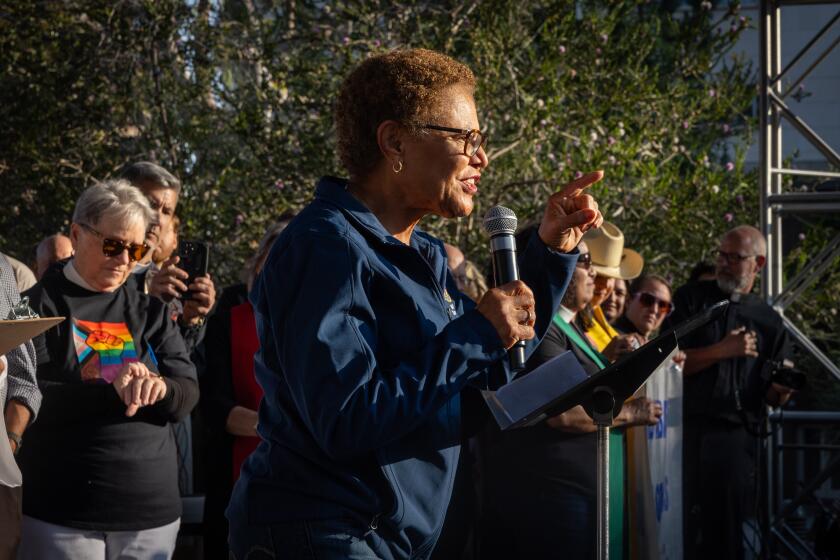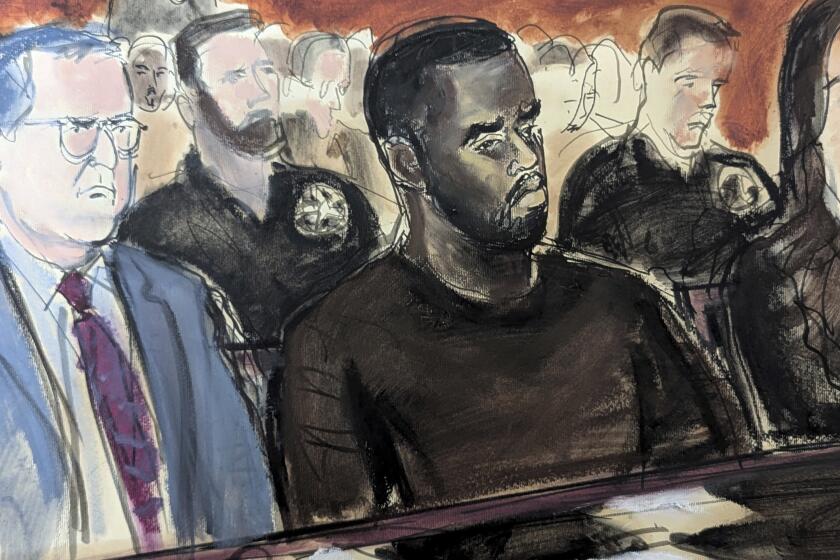Playing High-Stakes Electoral Poker: Can Casinos Fix Faltering Economies? : Elections: South Gate’s special election has split the community as the city struggles to maintain its version of the Southern California dream.
- Share via
On Tuesday, voters in South Gate will weigh conflicting claims of civic morality and municipal survival in an extraordinary special election. If Measure A passes, the “All-America City” with 90,000 residents will join six other communities in southern Los Angeles County’s “rust belt” that have legalized card casinos in desperate attempts to ballast local economies devastated by plant closures.
It will be one of the most expensive local elections in the history of Southern California. With a week of intensive campaigning still ahead, the South Gate City Clerk reported on Wednesday that opposing sides had already invested nearly $300,000 in an unprecedented direct-mail blitz. Considering turnouts for previous special elections, each vote on Oct. 22 will probably cost opponents $75-$115.
This high-stakes electoral poker is the culmination of a bleak saga of decline and fall in a city that once epitomized the blue-collar version of the Southern California dream.
Twenty years ago, South Gate’s prosperity seemed solidly anchored by a huge General Motors assembly plant, as well as Firestone Tire and Weiser Lock factories. Then, between 1979 and 1982, as a tsunami of Japanese imports swept away most of California’s heavy manufacturing, the lights began to go out in South Gate and other industrial suburbs along the Los Angeles River. With little warning, GM and Firestone shut down and Weiser Lock moved to Orange County.
Having lost its three major employers and 12,500 (peak figure) high-wage jobs, South Gate frantically reached for a life preserver called community redevelopment. But after a decade of bright promises and the expenditure of $26 million, redevelopment efforts have produced few results--though they have greatly embittered local politics.
Despite clearance of a residential neighborhood to make way for a proposed expansion, Weiser Lock left South Gate. A $2.7 million federal grant to revitalize the Firestone plant was used to subsidize a non-union furniture manufacturer to move 250 low-wage jobs from Iowa.
Under the slogan “From Smokestacks to Short Stacks,” the city has sought to reinforce its retail base, but as one redevelopment official admits, extravagant ground rent and tax writeoffs have virtually annulled any fiscal benefit from a major shopping center along Long Beach Boulevard. Meanwhile, hopes have melted that the former General Motors’ site at Tweedy Boulevard and Alameda Street--now a mostly vacant lot covered with salt grass and jimson weed--will ever metamorphose into the 2,700-employee business park visualized in 1985.
Finally, early in the summer, the Pete Ellis auto dealership, South Gate’s largest sales-tax generator, declared bankruptcy--despite $550,000 in outright grants and last-minute unsecured loans from the redevelopment agency. Dial-Purex, one of the city’s few surviving medium-sized manufacturers, immediately rubbed salt in the wound with the announcement that it would close its plant by the end of the year.
Although redevelopment officials have a few remaining rabbits up their sleeves (including a proposed medical-waste incinerator and a privatized prison), it has long been an open secret that the current City Hall regime--dominated by a conservative council member and former redevelopment director, Robert A. Phillip--has been waiting for an opportune moment to sell embattled South Gaters the panacea of a major hotel-casino complex.
Proponents of Measure A point to the example of Bell Gardens’ fabulous Bicycle Club, which pumps $11 million annually into that city’s coffers--55% of its municipal budget. Warning of an otherwise imminent fiscal crunch, City Manager Todd W. Argow argued, during a recent interview, that casinos’ income--especially from the lucrative Asian games like pai-gow-- could be used to “get the gangs out of town, clean up graffiti and make South Gate look classy again.” The alternative, in his view, is a drastic cutback in police services and inevitable decline to the status of a nightmare, urban Third World, epitomized by Watts nearby.
Opponents of Measure A, on the other hand, including veteran Democratic chieftain John Sheehy and UAW leader Henry C. Gonzalez, claim the proposed casino will only produce an epidemic of “drug dealing, loan sharking and prostitution.” They specifically cite racketeering indictments involving the City of Commerce casino in 1984.
The unprecedented magnitude of campaign contributions from outside South Gate has only added kerosene to the fire. The pro-Measure A forces are financed to the tune of $117,775, by developer Mary Wang, who represents the consortium of Asian investors who will build the $60-million hotel-casino if voters approve.
The “No on Measure A” Committee has so far received $130,700 from John P. Cunningham, president of International Window Corp., whose modern-looking and highly profitable aluminum-window factory, with its ideal freeway location, will be part of the “blight” redeveloped under eminent domain to build the hotel-casino. Meanwhile, George Hardie, flamboyant proprietor of the Bicycle Club and an aggressive defender of his bottom line, is filibustering in South Gate with a separate $41,000 No-on-A campaign.
With so many puppeteers manipulating so many strings, it is hard to discern the real sentiment at the grass roots. Perhaps the most genuinely populist gesture so far was the No-on-A demonstration Tuesday at the South Gate City Hall, organized by International Window employees belonging to Teamster Local 986.
Terrified by their company’s claim that it might have to relocate as far away as Fontana, the rank-and-file workers--mostly Spanish-speaking immigrants from central Mexico who live in South Gate and towns nearby--were incredulous that a city ravaged by deindustrialization, and confronting recession, would propose to displace 300 unionized jobs. In interviews over the last week, they spoke anxiously of shrinking job opportunities and failing schools, of the gnawing fear of losing the vital margin of economic stability accumulated over years of toil.
At any event, few International Window workers--or unemployed Dial-Purex employees, for that matter--will be eligible to vote in Tuesday’s plebiscite. Although Mexican immigrants and their children now comprise 83% of South Gate’s population, an aging Anglo minority still does most of the voting and holds the balance of political power. Only 4% of the population voted in the last municipal election and there is only one Latino on the current council--Vice Mayor, and casino supporter, Johnny Ramirez.
But South Gate is not atypical. Throughout Los Angeles County’s old industrial heartland, while population has doubled in the last 25 years, the active electorate has fallen by half. In addition, voters are disproportionately Anglo, with the increased Latino population not represented. Yet, with Tuesday’s vote, this shrunken electorate will make what both sides agree is an “epochal decision” about South Gate’s future.
More to Read
Sign up for Essential California
The most important California stories and recommendations in your inbox every morning.
You may occasionally receive promotional content from the Los Angeles Times.













